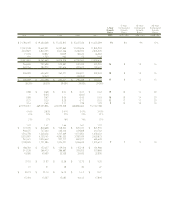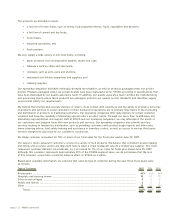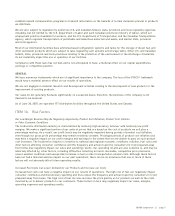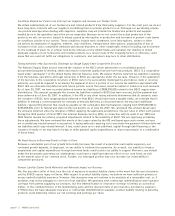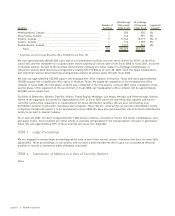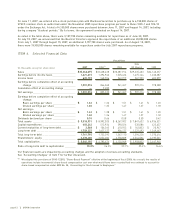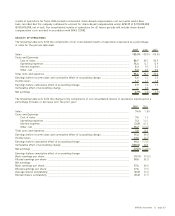Sysco 2007 Annual Report Download - page 31
Download and view the complete annual report
Please find page 31 of the 2007 Sysco annual report below. You can navigate through the pages in the report by either clicking on the pages listed below, or by using the keyword search tool below to find specific information within the annual report.establish hazard communication programs to transmit information on the hazards of certain chemicals present in products
we distribute.
We are also subject to regulation by numerous U.S. and Canadian federal, state, provincial and local regulatory agencies,
including, but not limited to, the U.S. Department of Labor and each Canadian provincial ministry of labour, which set
employment practice standards for workers, and the U.S. Department of Transportation and the Canadian Transportation
Agency, which regulate transportation of perishable and hazardous materials and waste, and similar state, provincial
and local agencies.
Most of our distribution facilities have ammonia-based refrigeration systems and tanks for the storage of diesel fuel and
other petroleum products which are subject to laws regulating such systems and storage tanks. Other U.S. and Canadian
federal, state, provincial and local provisions relating to the protection of the environment or the discharge of materials
do not materially impact the use or operation of our facilities.
Compliance with these laws has not had, and is not anticipated to have, a material effect on our capital expenditures,
earnings or competitive position.
GENERAL
We have numerous trademarks which are of significant importance to the company. The loss of the SYSCO»trademark
would have a material adverse effect on our results of operations.
We are not engaged in material research and development activities relating to the development of new products or the
improvement of existing products.
Our sales do not generally fluctuate significantly on a seasonal basis; therefore, the business of the company is not
deemed to be seasonal.
As of June 30, 2007, we operated 177 distribution facilities throughout the United States and Canada.
ITEM 1A. Risk Factors
Our Low Margin Business May Be Negatively Impacted by Product Cost Deflation, Product Cost Inflation
or Other Economic Conditions
The foodservice distribution industry is characterized by relatively high inventory turnover with relatively low profit
margins. We make a significant portion of our sales at prices that are based on the cost of products we sell plus a
percentage markup. As a result, our profit levels may be negatively impacted during periods of product cost deflation,
even though our gross profit percentage may remain relatively constant. Prolonged periods of product cost inflation also
may have a negative impact on our profit margins and earnings to the extent that we are unable to pass on such product
cost increases. The foodservice industry is sensitive to national and regional economic conditions. Inflation, fuel costs and
other factors affecting consumer confidence and the frequency and amount spent by consumers for food prepared away
from home may negatively impact our sales and operating results. Our operating results are also sensitive to, and may be
adversely affected by, other factors, including difficulties collecting accounts receivable, competitive price pressures,
severe weather conditions and unexpected increases in fuel or other transportation-related costs. Although these factors
have not had a material adverse impact on our past operations, there can be no assurance that one or more of these
factors will not adversely affect future operating results.
Increased Fuel Costs Can Lower Demand for our Products and Increase our Costs
Increased fuel costs can have a negative impact on our results of operations. The high cost of fuel can negatively impact
consumer confidence and discretionary spending and thus reduce the frequency and amount spent by consumers for food
prepared away from home. The high cost of fuel can also increase the price paid by us for products as well as the costs
incurred by us to deliver products to our customers. These factors in turn may negatively impact our sales, margins,
operating expenses and operating results.
SYSCO Corporation ][ page 5


